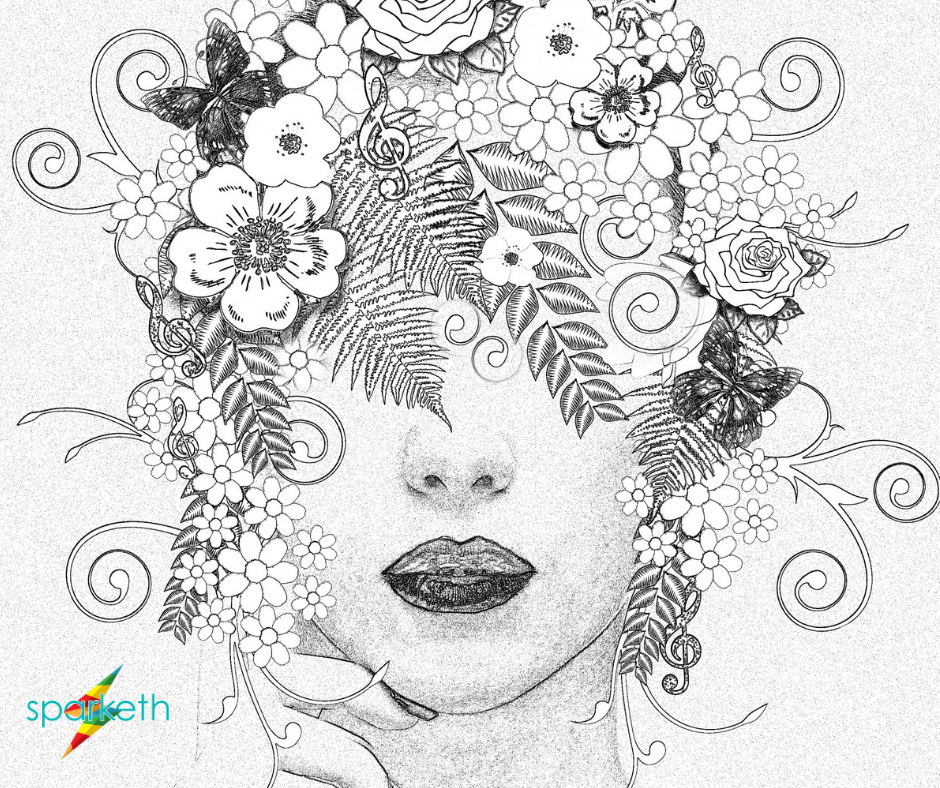For creative people, our art is more than just work. It’s also deeply personal.
Whether your creative passion is painting, writing, music, digital content creation (or one of the numerous other creative endeavors), the internal pressure to only create your best can grow until it becomes the thing all creatives fear the most: the dreaded creative block.
And because we creatives take so much pride in our work, a creative block is beyond frustrating. It can be personally devastating. Even worse, a creative block can become a tricky cycle, messing up for your creative flow for days, weeks, months, or even years….IF you let it.
So don’t let it!
If you are a creative person, you will inevitably face a creative block at some point. It’s simply the nature of the beast. The trick is to not let it stop you from creating– and to get back into a creative flow as soon as you can.
At Sparketh, we’re all about nourishing creativity for kids, teens (and adults too). Every member on our team is a creative, and we get how frustrating it can be to find yourself creatively stumped. We also know how important it is to not let those moments get you down for long. If you’ve recently had a creative block interrupt your flow, here are 10 tips to help you get it back!
1. Practice Everyday
This tip is #1 because it is literally the #1 most important thing you can do to get back into a creative flow. Because guess what? When you’re not feeling creative, it’s even more important to keep creating! And here’s a little secret: once you start creating everyday, inspiration will begin to make more regular appearances, too. Practice is fertile ground for creativity.
Artists and writers often refer to the creative Muses of Greek mythology, sometimes even giving procrastination an excuse by saying things like: “I’m just waiting for the Muse to strike.” The truth is that we give “the Muse” a pretty poor environment when we’re not working our creative muscles regularly. When you make a habit of practicing everyday, you’re pretty much telling your personal (theoretical) “creative Muse” that your door is open to inspiration.
The other important aspect of this tip is to be realistic in your daily goals. Don’t say, “I’m going to paint/write/practice the violin for 3 hours a day,” if you know that’s not something you can realistically work into your life. Start smaller. Keep it doable. Give yourself no excuses for not following through. Practice everyday.
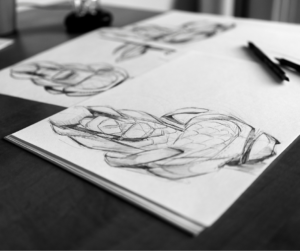
2. Get inspired by others’ work.
In an interview for our Website, Sparketh‘s co-founder and CEO, Dwayne Walker said: “Creativity is always an extension of you. You can only create as far as you know, which is why it’s always important to keep learning.”
One of the best ways to be more creative (and get your creative flow back) is to dive deeply into learning and studyng the work of other creatives! If you’re a writer, read as much great writing as possible. If you’re a visual artist, go spend some time at your local museum, check out some of your favorite artists’ work in a book or online, or take an online art class to learn something new in a hands-on way. You’ll almost always find that it’s natural to get inspired when you’re learning and studying others’ work.
3. Limit Yourself
“Limiting” or “narrowing in” on specific subjects, techniques, or work spaces can prompt creativity and increase your creative focus. Sparketh art instructor (and TikTok content creator) Amy contributed this clever tip. Speaking especially to visual artists, she demonstrated how (for example) limiting the subject that you are drawing or painting can allow you to try approaching the same subject in a variety of styles and techniques. If you find a subject/technique combination that speaks to you, you can “limit” yourself even further by trying some variations within those confines. You can apply this principal to whatever your creative interests are!
You can also limit your surroundings by going somewhere specifically for the purpose of creating, or limit your time by utilizing timers and setting deadlines. Setting these kinds of limits with your daily creative time can help you get into a creative flow more easily, no matter what your creative passive is. For more on this tip, you can watch Amy’s video, here.
4. Create gifts for the people in your life.
Another strategy that can motivate you to create is to find a simple, low-pressure creative project that you can do quickly, repeat often, and give away. This can work well alongside the “narrowing in/limiting yourself” technique, while also giving you external motivation to create.
For example, at the beginning of the Covid-19 pandemic, I got into the habit of making literary-themed watercolor bookmarks for my friends and sending them off in the mail. Each one only took me about 20 minutes. Every time I set out to make one, I automatically had a specific prompt: “What is that person’s favorite book?” I also had the fulfilling satisfaction that comes from making something for a friend. A lot of people found ways to get creative making things for people they cared about during this time of isolation. Some people baked for others, or made friendship bracelets, participated in TikTok dance challenges with friends, or played songs for people on Zoom.
I’m not saying we need to be in a pandemic/isolation to do this. However, I think that this time forced people to get creative about connecting, which resulted in a creative surge for many. There’s something very motivating and satisfying about using your creative interests to show someone you care.
5. Try a different setting.
Are you a morning person or a night person? Do background noises help you focus, or are they a distraction? Do you need privacy to be creative, or do you work best surrounded by other people?
We are all so different when it comes to finding the optimum creative environment. When you are trying to get into the habit of practicing creativity everyday, experiment with some different background settings. You may want to try getting up early, when everything is quiet. Or maybe working in a busy living room with the TV on makes you feel less pressured and more comfortable. Maybe it helps you out to go somewhere different- like a park or bookstore- to be creative (like in tip #3).
Sometimes, I’ve even found that sitting somewhere random in my house can help me be more productive (like on the floor of a room I’m not in very often). Play around with some different times and spaces and see what works for you to get you in a creative mindset.
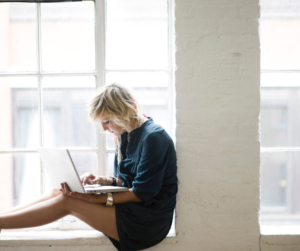
7. Keep a journal or a sketch diary.
A great way to get in touch with your creative mind is to let it talk to you! Keeping a daily journal or sketch diary is an awesome, low-pressure way to get in touch with thoughts that you might not even be aware of. This is also a daily practice (*cough* tip #1) that is totally doable.
You’ll find that once you get in the habit of observing and documenting via a written or sketch journal, inspiration seems to come from everywhere. Your brain will naturally begin to start looking at things from a creative perspective. A documentation of things that stick out to you can also reveal your hidden interests and prompt new ideas!
8. Make a plan and tell others.
We all do better with deadlines and accountability. Being creative can often be a solo activity, so you end up being responsible for motivating yourself. This is one of the reasons that it can be so hard to get back into a creative flow after experiencing creative roadblocks.
When you don’t feel very creative, you may tell yourself “you’ll do it tomorrow.” Those “tomorrows” can add up. If this is something you’ve experienced, then this tip is for you: make a specific plan for your creative goals, and tell others about it.
Technology can help, too! Some people create digital calendars that will send them bossy e-mails everyday to remind them of their goals. Many creatives share their general and specific creative goals with friends on social media, alongside daily updates. Some people even livestream their worktime to stay focused and accountable.
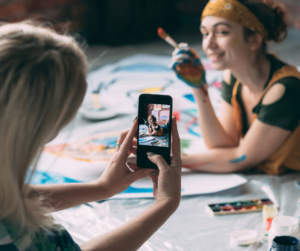
However you approach it, making a plan and asking for accountability can help you stick to your daily practices and ultimately get into a better creative flow.
9. Give yourself permission to create something bad.
When you feel creatively empty, remind yourself that, “something is better than nothing.” So often, the creative roadblocks that we face comes directly from the pressure that we create for ourselves. If you’re lacking inspiration, you may feel terrified of creating something bad, or of being faced with the feeling that you’ve lost your skills.
However, the truth is that something – anything -you create is going to be better than nothing! Remind yourself of some of the other tips we’ve already covered, and how creative practice can be a creative prompt in and of itself (even if what you create isn’t that good!)
The poet Maya Angelou, once said: “You can’t use up creativity. The more you use, the more you have.” Use whatever little creativity you have inside of you (even when it doesn’t feel like much.) It will never be wasted. The best creatives have to create a lot of mediocre stuff before they come up with masterpieces, so give yourself permission to create something bad! You’re in good company.
10. Surround yourself with fellow creatives.
I mentioned that creativity can often feel like a solo activity. Many times -in practice- it is. However, creativity is also something brings people together. We’re always creating with the intention of sharing with, and communicating with others. Connection, therefore, is really at the heart of creativity.
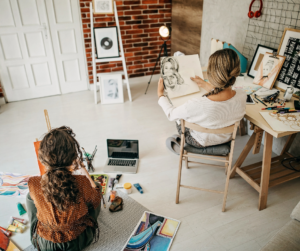
Surrounding yourself with other creatives (in your same area of interest, or otherwise) can be an important source of inspiration, accountability, and community. A great way to start connecting with other creatives is simply to tell others that you are one. Talk about your art, or your writing, or music (whatever it is!) And ask other people if they like to create, too! I bet you’ll find, pretty quickly, that you’re not alone. Not only is that a good feeling, but it’s also a constant source of creative inspiration and encouragement.
If you’ve been struggling with any creative roadblocks lately, we hope that these 10 tips helped you out! At Sparketh, our desire is to nourish creativity and create an online space where kids and teens can be their most creative selves. We think that being creative is one of the most important things you can be, and we’re here to help you in your creative journey.


